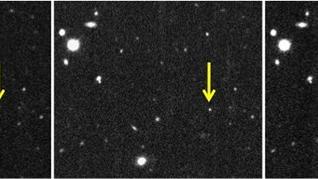Super-Earth
Latest

NASA finds 'super-Earth' with an atmosphere it can analyse
Astronomers at NASA, working with the ESA and the University College London, announced Tuesday that they have discovered a "super-Earth" exoplanet with an atmosphere, that, for the first time, they can analyse. The Hubble telescope's Wide Field Camera 3 (WFC3) first spotted the planet, dubbed 55 Cancri e, which is only about 40 light years away. Super-earths are simply rocky planets that are bigger than the Earth -- in this case, eight times bigger. They're widely believed to be the most common type of rocky planet in the galaxy.

Newly discovered dwarf planet could challenge what we know about our solar system
While Pluto might have been stripped of its full planetary status, thanks to a shift in official definitions, a newly discovered planetoid could actually hint at the existence of a "super-Earth" in the far reaches of our solar system. The ball of rock and ice, known as 2012 VP113, is estimated to be 250 miles wide, and has the most distant known orbit of our sun -- currently around 7.7 billion miles, extending to around 42 billion at its farthest. 2012 VP113 was spotted using the Dark Energy Camera in Chile, after a series of time-lapse photos captured it moving across the night sky.

Astronomers find three planets in Gliese 667C's habitable zone
Astronomers have a good day when they detect one planet inside a star system's habitable zone. A mostly European team of researchers must be giddy, then, as it just found three of those ideally located planets around Gliese 667C. The group has combined existing observations from the ESO's Very Large Telescope with new HARPS telescope data to spot the trio of super-Earths, all of which could theoretically support liquid water. As long as the discovery holds up, it may have a big impact on exoplanetary research: it shows both that three super-Earths can exist in one system and that more than one survivable planet can orbit a low-mass star. We can only do so much with the findings when Gliese 667C is 22 light-years away, but it's good to learn that space could be more human-friendly than we once thought.

Potentially inhabitable super-Earth discovered in 6 planet solar system
When we do eventually reduce the Earth to an uninhabitable wasteland through our careless consumption of natural resources and inevitable nuclear wars, we'll need someplace else to go. We haven't picked a successor yet, but a new candidate has been identified a mere 44 light years away, orbiting dwarf star HD 40307. The super-Earth orbits its host star right at the edge of the so-called habitable zone, where a stable atmosphere and liquid water are possible. We don't know for sure the planet is, in fact, capable of supporting life, but there's at least a chance. And given that it's roughly seven-times the mass of Earth, it shouldn't have much trouble playing host to our exploding population.

Alt-week 27.10.12: ancient texts, super-Earths and special-ops mice
Alt-week peels back the covers on some of the more curious sci-tech stories from the last seven days. If, like us, you struggle to read the front of the Corn Flakes box of a morning, you likely gave up any hope of cracking ancient codes long ago. If you didn't, however, then your time might be now -- as one of the oldest scripts know to man is still up for grabs. Prefer just to observe? No problem, as we've got super-Earth-searching satellites, military mice and vertical farms, all for your viewing reading pleasure. If you hadn't guessed already, this is alt-week

New super-Earth detected, 'best candidate' for supporting life
A new potentially life-bearing "super-Earth" has been discovered orbiting a relatively nearby star. Described as the "best candidate" for supporting liquid water -- and therefore life -- the planet (GJ 667Cc) is believed to be about 4.5 times the size of Earth. The parent star (GJ 667C) is 22 light years away, and this is the second potentially Earth-like rock scientists have discovered orbiting the M-class dwarf. With a 28.15 day cycle, it's calculated to receive 90 percent as much light as Earth, and much of that is infrared (meaning the actual energy delivered is about equal) -- crucially hinting at similar temperatures and favorable conditions. Not enough is known about the atmosphere right now to fully nail the water prospects, but it's still our best hope of discovering life as we (don't) know it yet.



